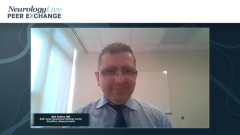
Emerging Therapies for Migraine
Experts in headache medicine review novel therapeutic agents under investigation and the evolving treatment landscape for migraine.
Episodes in this series

Jessica Ailani, MD: In this segment we're going to be talking about emerging treatment options. And I have to say this is when my inner nerd comes out; and this is probably the part that I would forward to and watch first because I love to hear from my colleagues about the latest and greatest science, where our field is going, get all the trade secrets, and find out what's being investigated and where we might get new targets. Andy, I thought we'd start with you, and you can tell us about any new novel therapeutic agents or new mechanisms of action that are under investigation for treatment of migraine and how you think any new therapeutic targets are going to help advance our treatments in migraine.
Andrew C. Charles, MD: There's still, believe it or not, a host of different therapeutic targets. Even though we've been at this for a while, there still are multiple others that we haven't necessarily scratched the surface of yet. Among these are other neuropeptides. PACAP [pituitary adenylate-cyclase-activating polypeptide], for example, is 1 that we could think about as an alternative to CGRP [calcitonin gene-related peptide]-targeted therapies, or maybe in combination, a variety of other neurotransmitters, glutamate receptors, and adenosine receptors. Adenosine is the target of caffeine, for example, which we know has different effects on migraine. There are different subtypes of opioid receptors. There are a variety of iron channels that are targets, namely potassium channels and sodium channels. There’s a host of treatment targets that are out there that we need to keep working on. I'll say that 1 of the things that we haven't done that well with as a field is figuring out when we have therapies that work well, what is the specific mechanism of action? We often just get 1 mechanism and just assume that that's it. CGRP is a good example. We think about it as primarily released in the trigeminal vascular system, but CGRP is all over the nervous system. It may affect function of the hypothalamus, for example—the brain stem—that has CGRP receptors, as does the cerebellum. As you say, there are a variety of locations where CGRP could be released and be important in migraine. And, understanding when we have a patient for whom something works well, why is that? And then conversely, if we have people that don't respond at all, why is that? Taking the clinical information about efficacy or nonefficacy and trying to better understand that with preclinical and clinical research is something that gets me excited.
Jessica Ailani, MD: I spend a ridiculous amount of time thinking about this, Andy. It is fascinating—even just the idea of the monoclonal antibodies and the gepants and how much we've learned when they came to market in clinical practice by realizing you can respond to both together, you can respond to 1 and not another, you can respond to 1 monoclonal and not another monoclonal. You can respond to 1 gepant, not another gepant. What does this mean about what's happening in a patient, specifically, and how there are probably other targets involved, not just CGRP, and how fascinating that can be? But how unfortunate that means that we don't understand even something that's so specified. But that implication is important when we're treating patients who we're telling this is it, this is a specified treatment, but guess what? It's maybe not as specific as we think. That's very hopeful because it means we still have other targets we're hitting, and we are going to have more in the future, so there’s lots of great stuff coming. Sait, what do you want to see emphasized in continued research in development for migraine treatments? Andy talked to us about all these different receptors. I mentioned things we're learning from clinical practice. What do you want to see in the treatment spectrum and how it's going to take shape over the next several years?
Sait Ashina, MD: Well, Andy gave an example. There are a lot of new possible treatments that are going to be emerging in the future, and there are a lot of neuropeptides involved. There are pathways like nitric oxide, glutamate pathways that can modulate it. There are also downstream mechanisms. From the fact that you’re blocking receptors, but then what happens down further, these pathways could be narrowed down and modulated as well. And there's some work going on on those pathways as well. And when we talk about migraine, we can't just say like 1 molecule is the only modulator of pathophysiology. Migraine is a complex neurovascular neurological condition or disorder, and it's a brain disorder too. There are a lot of multiple pathways. There's interaction with the environment. We know that weather changes can trigger migraines. We know that's probably mediated by hepatology too, right? There are a lot of potential targets. It's not so simplistic. That's why I think there is a place for different treatments or different targets. And sometimes you're combining, for example, CGRP targeting to treat the migraines more efficiently. I believe that in the future we'll have so-called rational polypharmacy like we do with other conditions. Like with epilepsy, for instance, we use a combination of medications to get to the optimal treatment for improvement. What I'm looking for is how the combinations of this new drug are working. And we need to have more studies; we need to have the studies to bring more evidence and then offer them in the future to our patients.
Jessica Ailani, MD: Multimodal therapies and not only medications, but how do we layer neuromodulation, behavioral therapy, and medication and lifestyle, and how is this all working in a single person when we're targeting all of these things? I totally agree.
Sait Ashina, MD: Without doubt, we know that mindfulness techniques now are used in addition to the pharmacotherapies to optimize the treatments and improve the outcomes.
Jessica Ailani, MD: Yes, definitely.
Transcript Edited for Clarity
Newsletter
Keep your finger on the pulse of neurology—subscribe to NeurologyLive for expert interviews, new data, and breakthrough treatment updates.






























